Fracture Behavior of Permeable Asphalt Mixtures with Steel Slag under Low Temperature Based on Acoustic Emission Technique
Abstract
:1. Introduction
2. Materials and Methods
2.1. Raw Materials and Mixture Design
2.2. Specimen Preparation
- Step1: Place the weighed aggregates and mineral powder in the oven at 180 °C for 6 h and heat the SBS-modified bitumen to 180 °C to reach the viscosity required for mixing.
- Step2: Place the preheated aggregates in a constant temperature mixing pot and stir for 90 s. Then, add the weighed SBS-modified bitumen and stir for another 90 s. Finally, add the preheated filler to mixing for 90 s.
- Step3: Use a standard Marshall hammer to compact the specimens with 50 blows per side.
- Step4: Demold the specimens after 12 h.
2.3. Volume Characteristics and Mechanical Properties
2.4. Acoustic Emission (AE) Test
2.4.1. Setup
2.4.2. AE Basic Parameters
2.4.3. Rise Angle (RA) and Average Frequency (AF)
2.4.4. b-Value
3. Results and Discussion
3.1. Sentry Function Analysis
3.2. Rise Angle (RA) and Average Frequency (AF) Analysis
3.2.1. Average RA and AF
3.2.2. Cumulative RA and AF
3.2.3. The Determination of the Boundary Line
3.2.4. Fracture Mode Classification
3.3. b-Value Analysis
4. Conclusions
Author Contributions
Funding
Acknowledgments
Conflicts of Interest
References
- Jiang, W.; Sha, A.M.; Xiao, J.J.; Li, Y.L.; Huang, Y. Experimental study on filtration effect and mechanism of pavement runoff in permeable asphalt pavement. Constr. Build. Mater. 2015, 100, 102–110. [Google Scholar] [CrossRef]
- Tang, T.C.; Anupam, K.; Kasbergen, C.; Scarpas, A.; Erkens, S. A finite element study of rain intensity on skid resistance for permeable asphalt concrete mixes. Constr. Build. Mater. 2019, 220, 464–475. [Google Scholar] [CrossRef]
- Xie, N.; Akin, M.; Shi, X.M. Permeable concrete pavements: A review of environmental benefits and durability. J. Clean. Prod. 2019, 210, 1605–1621. [Google Scholar] [CrossRef]
- Tziampou, N.; Coupe, S.J.; Sañudo–Fontaneda, L.A.; Newman, A.P.; Castro–Fresno, D. Fluid transport within permeable pavement systems: A review of evaporation processes, moisture loss measurement and the current state of knowledge. Constr. Build. Mater. 2020, 243, 118179. [Google Scholar] [CrossRef]
- Xu, B.; Chen, J.Y.; Zhou, C.H.; Wang, W.Y. Study on Marshall Design parameters of porous asphalt mixture using limestone as coarse aggregate. Constr. Build. Mater. 2016, 124, 846–854. [Google Scholar] [CrossRef]
- Wang, X.W.; Gu, X.Y.; Jiang, J.W.; Deng, H.Y. Experimental analysis of skeleton strength of porous asphalt mixtures. Constr. Build. Mater. 2018, 171, 13–21. [Google Scholar] [CrossRef]
- Skaf, M.; Manso, J.M.; Aragón, Á.; Fuente-Alonso, J.A.; Ortega-López, V. EAF slag in asphalt mixes: A brief review of its possible re-use. Resour. Conserv. Recycl. 2017, 120, 176–185. [Google Scholar] [CrossRef]
- World Steel Association. World Steel in Figures. 2020. Available online: https://www.worldsteel.org/en/dam/jcr:f7982217-cfde-4fdc-8ba0-795ed807f513/World%2520Steel%2520in%2520Figures%25202020i.pdf (accessed on 30 April 2020).
- Guo, J.L.; Bao, Y.P.; Wang, M. Steel slag in China: Treatment, recycling, and management. Waste Manag. 2018, 78, 318–330. [Google Scholar] [CrossRef]
- Wang, S.X.; Zhang, G.F.; Wang, B.; Wu, M. Mechanical strengths and durability properties of pervious concretes with blended steel slag and natural aggregate. J. Clean. Prod. 2020, 271, 122590. [Google Scholar] [CrossRef]
- Esther, L.-A.; Pedro, L.-G.; Irune, I.-V.; Gerardo, F. Comprehensive analysis of the environmental impact of electric arc furnace steel slag on asphalt mixtures. J. Clean. Prod. 2020, 275, 123121. [Google Scholar] [CrossRef]
- Zhou, X.X.; Zhao, G.Y.; Tighe, S.S.; Chen, M.Z.; Wu, S.P.; Adhikari, S.; Gao, Y.M. Quantitative comparison of surface and interface adhesive properties of fine aggregate asphalt mixtures composed of basalt, steel slag, and andesite. Constr. Build. Mater. 2020, 246, 118507. [Google Scholar] [CrossRef]
- Zhang, G.F.; Wang, S.X.; Wang, B.; Zhao, Y.J.; Kang, M.; Wang, P.M. Properties of pervious concrete with steel slag as aggregates and different mineral admixtures as binders. Constr. Build. Mater. 2020, 257, 119543. [Google Scholar] [CrossRef]
- Shen, W.G.; Liu, Y.; Wu, M.M.; Zhang, D.; Du, X.J.; Zhao, D.Q.; Xu, G.L.; Zhang, B.L.; Xiong, X. Ecological carbonated steel slag pervious concrete prepared as a key material of sponge city. J. Clean. Prod. 2020, 256, 120244. [Google Scholar] [CrossRef]
- Kusumawardani, D.M.; Wong, Y.D. The influence of aggregate shape properties on aggregate packing in porous asphalt mixture (PAM). Constr. Build. Mater. 2020, 255, 119379. [Google Scholar] [CrossRef]
- Mo, L.W.; Yang, S.; Huang, B.; Xu, L.L.; Feng, S.F.; Deng, M. Preparation, microstructure and property of carbonated artificial steel slag aggregate used in concrete. Cem. Concr. Compos. 2020, 113, 103715. [Google Scholar] [CrossRef]
- Cui, P.D.; Wu, S.P.; Xiao, Y.; Yang, C.; Wang, F. Enhancement mechanism of skid resistance in preventive maintenance of asphalt pavement by steel slag based on micro-surfacing. Constr. Build. Mater. 2020, 239, 117870. [Google Scholar] [CrossRef]
- Skaf, M.; Pasquini, E.; Revilla-Cuesta, V.; Ortega-Lopez, V. Performance and Durability of Porous Asphalt Mixtures Manufactured Exclusively with Electric Steel Slags. Materials 2019, 12, 3306. [Google Scholar] [CrossRef] [Green Version]
- Rodríguez-Fernández, I.; Lizasoain-Arteaga, E.; Lastra-González, P.; Castro-Fresno, D. Mechanical, environmental and economic feasibility of highly sustainable porous asphalt mixtures. Constr. Build. Mater. 2020, 251, 118982. [Google Scholar] [CrossRef]
- Chen, J.-S.; Yang, C.H.; Lee, C.-T. Field evaluation of porous asphalt course for life-cycle cost analysis. Constr. Build. Mater. 2019, 221, 20–26. [Google Scholar] [CrossRef]
- Yan, K.Z.; Sun, H.; You, L.Y.; Wu, S.H. Characteristics of waste tire rubber (WTR) and amorphous poly alpha olefin (APAO) compound modified porous asphalt mixtures. Constr. Build. Mater. 2020, 253, 119071. [Google Scholar] [CrossRef]
- Wu, J.T.; Wang, Y.H.; Liu, Q.; Wang, Y.; Ago, C.; Oeser, M. Investigation on mechanical performance of porous asphalt mixtures treated with laboratory aging and moisture actions. Constr. Build. Mater. 2020, 238, 117694. [Google Scholar] [CrossRef]
- Ohtsu, M. Elastic wave methods for NDE in concrete based on generalized theory of acoustic emission. Constr. Build. Mater. 2016, 122, 845–854. [Google Scholar] [CrossRef]
- Behnia, A.; Chai, H.K.; Shiotani, T. Advanced structural health monitoring of concrete structures with the aid of acoustic emission. Constr. Build. Mater. 2014, 65, 282–302. [Google Scholar] [CrossRef]
- Cortés, G.; Suarez, E.; Gallego, A.; Benavent–Climent, A. Health monitoring of reinforced concrete structures with hysteretic dampers subjected to dynamical loads by means of the acoustic emission energy. Struct. Health Monit. 2018, 18, 1836–1850. [Google Scholar] [CrossRef]
- Barile, C.; Casavola, C.; Pappalettera, G.; Kannan, V.P. Application of different acoustic emission descriptors in damage assessment of fiber reinforced plastics: A comprehensive review. Eng. Fract. Mech. 2020, 235, 107083. [Google Scholar] [CrossRef]
- Omondi, B.; Aggelis, D.G.; Sol, H.; Sitters, C. Improved crack monitoring in structural concrete by combined acoustic emission and digital image correlation techniques. Struct. Health Monit. 2016, 15, 359–378. [Google Scholar] [CrossRef]
- Li, W.J.; Ho, S.C.M.; Patil, D.; Song, G.B. Acoustic emission monitoring and finite element analysis of debonding in fiber–reinforced polymer rebar reinforced concrete. Struct. Health Monit. 2016, 16, 674–681. [Google Scholar] [CrossRef]
- Liu, H.B.; Li, W.J.; Luo, G.B.; Liu, S.Q.; Lyu, X. Mechanical Properties and Fracture Behavior of Crumb Rubber Basalt Fiber Concrete Based on Acoustic Emission Technology. Sensors 2020, 20, 3513. [Google Scholar] [CrossRef] [PubMed]
- Behnia, B.; Dave, E.V.; Buttlar, W.G.; Reis, H. Characterization of embrittlement temperature of asphalt materials through implementation of acoustic emission technique. Constr. Build. Mater. 2016, 111, 147–152. [Google Scholar] [CrossRef]
- Wei, H.; Hu, B.; Wang, F.Y.; Zheng, J.L.; Jin, J.; Liu, C.C. Temporal–spatial evolution characteristics of acoustic emission in asphalt concrete cracking process under low temperature. Constr. Build. Mater. 2020, 248, 118632. [Google Scholar] [CrossRef]
- Qiu, X.; Xu, J.X.; Xu, W.Y.; Xiao, S.L.; Wang, F.; Yuan, J. Characterization of fatigue damage mechanism of asphalt mixtures with acoustic emission. Constr. Build. Mater. 2020, 240, 117961. [Google Scholar] [CrossRef]
- Qiu, X.; Xu, J.X.; Xiao, S.L.; Yang, Q. Acoustic emission parameters and waveforms characteristics of fracture failure process of asphalt mixtures. Constr. Build. Mater. 2019, 215, 135–147. [Google Scholar] [CrossRef]
- Sun, Z.; Behnia, B.; Buttlar, W.G.; Reis, H. Acoustic emission quantitative evaluation of rejuvenators to restore embrittlement temperatures to oxidized asphalt mixtures. Constr. Build. Mater. 2016, 126, 913–923. [Google Scholar] [CrossRef]
- Cui, P.D.; Wu, S.P.; Xiao, Y.; Niu, Y.Y.; Yuan, G.M.; Lin, J.T. 3D reconstruction of moisture damage resulted volumetric changes in porous asphalt mixture. Constr. Build. Mater. 2019, 228, 116658. [Google Scholar] [CrossRef]
- Yi, J.Y.; Shen, S.H.; Muhunthan, B.; Feng, D.C. Viscoelastic–plastic damage model for porous asphalt mixtures: Application to uniaxial compression and freeze–thaw damage. Mech. Mater. 2014, 70, 67–75. [Google Scholar] [CrossRef]
- Jiao, Y.B.; Fu, L.X.; Shan, W.C.; Liu, S.Q. Damage fracture characterization of pervious asphalt considering temperature effect based on acoustic emission parameters. Eng. Fract. Mech. 2019, 210, 147–159. [Google Scholar] [CrossRef]
- Jiao, Y.; Zhang, Y.; Zhang, M.S.; Fu, L.X.; Zhang, L.D. Investigation of fracture modes in pervious asphalt under splitting and compression based on acoustic emission monitoring. Eng. Fract. Mech. 2019, 211, 209–220. [Google Scholar] [CrossRef]
- Cai, X.; Fu, L.X.; Zhang, J.Y.; Chen, X.H.; Yang, J. Damage analysis of semi–flexible pavement material under axial compression test based on acoustic emission technique. Constr. Build. Mater. 2020, 239, 117773. [Google Scholar] [CrossRef]
- Chai, C.; Cheng, Y.C.; Zhang, Y.W.; Chen, Y.; Zhu, B. Experimental Study on the Performance Decay of Permeable Asphalt Mixture in Seasonally Frozen Regions under Freeze–Thaw Cycles. Sustainability 2020, 12, 2966. [Google Scholar] [CrossRef] [Green Version]
- Xu, S.; Liu, X.; Tabaković, A.; Schlangen, E. A novel self-healing system: Towards a sustainable porous asphalt. J. Clean. Prod. 2020, 259, 120815. [Google Scholar] [CrossRef]
- Zhang, Z.W.; Sha, A.M.; Liu, X.; Luan, B.; Gao, J.; Jiang, W.; Ma, F. State-of-the-art of porous asphalt pavement: Experience and considerations of mixture design. Constr. Build. Mater. 2020, 262, 119998. [Google Scholar] [CrossRef]
- Ministry of Housing and Urban–Rural Development of the People’s Republic of China. CJJ T190–2012. Technical Specification for Permeable Asphalt Pavement; Ministry of Housing and Urban–Rural Development of the People’s Republic of China: Beijing, China, 2012. (In Chinese)
- Carpinteri, A.; Lacidogna, G.; Accornero, F.; Mpalaskas, A.C.; Matikas, T.E.; Aggelis, D.G. Influence of damage in the acoustic emission parameters. Cem. Concr. Compos. 2013, 44, 9–16. [Google Scholar] [CrossRef]
- Jiao, Y.B.; Liu, S.Q.; Fu, L.X.; Shan, W.C. Fracture Monitoring of SBS and Crumb Rubber Modified Porous Asphalt Mixtures under Compression and Splitting Testing Using Acoustic Emission Technique. J. Mater. Civ. Eng. 2019, 31, 04019063. [Google Scholar] [CrossRef]
- Davijani, A.A.B.; Hajikhani, M.; Ahmadi, M. Acoustic Emission based on sentry function to monitor the initiation of delamination in composite materials. Mater. Des. 2011, 32, 3059–3065. [Google Scholar] [CrossRef]
- Selman, E.; Ghiami, A.; Alver, N. Study of fracture evolution in FRP–strengthened reinforced concrete beam under cyclic load by acoustic emission technique: An integrated mechanical–acoustic energy approach. Constr. Build. Mater. 2015, 95, 832–841. [Google Scholar] [CrossRef]
- Barile, C.; Casavola, C.; Pappalettera, G.; Vimalathithan, P.K. Damage characterization in composite materials using acoustic emission signal–based and parameter–based data. Compos. Part B Eng. 2019, 178, 107469. [Google Scholar] [CrossRef]
- Saeedifar, M.; Najafabadi, M.A.; Zarouchas, D.; Toudeshky, H.H.; Jalalvand, M. Barely visible impact damage assessment in laminated composites using acoustic emission. Compos. Part B Eng. 2018, 152, 180–192. [Google Scholar] [CrossRef] [Green Version]
- Noorsuhada, M.N. An overview on fatigue damage assessment of reinforced concrete structures with the aid of acoustic emission technique. Constr. Build. Mater. 2016, 112, 424–439. [Google Scholar] [CrossRef]
- JCMS–III B5706. Monitoring Method for Active Cracks in Concrete by Acoustic Emission; Federation of Construction Materials Industries: Tokyo, Japan, 2003. [Google Scholar]
- Farhidzadeh, A.; Salamone, S.; Luna, B.; Whittaker, A. Acoustic emission monitoring of a reinforced concrete shear wall by b–value–based outlier analysis. Struct. Health Monit. 2012, 12, 3–13. [Google Scholar] [CrossRef]
- Zhang, Q.; Zhang, X.P. A numerical study on cracking processes in limestone by the b–value analysis of acoustic emissions. Comput. Geotech. 2017, 92, 1–10. [Google Scholar] [CrossRef]
- Datt, P.; Kapil, J.C.; Kumar, A. Acoustic emission characteristics and b–value estimate in relation to waveform analysis for damage response of snow. Cold Reg. Sci. Technol. 2015, 119, 170–182. [Google Scholar] [CrossRef]
- Sagasta, F.; Zitto, M.E.; Piotrkowski, R.; Benavent–Climent, A.; Suarez, E.; Gallego, A. Acoustic emission energy b–value for local damage evaluation in reinforced concrete structures subjected to seismic loadings. Mech. Syst. Signal Proc. 2018, 102, 262–277. [Google Scholar] [CrossRef]
- Tragazikis, I.Κ.; Dassios, K.G.; Dalla, P.T.; Exarchos, D.A.; Matikas, T.E. Acoustic emission investigation of the effect of graphene on the fracture behavior of cement mortars. Eng. Fract. Mech. 2019, 210, 444–451. [Google Scholar] [CrossRef]
- Liu, H.B.; Zhu, B.; Wei, H.B.; Chai, C.; Chen, Y. Laboratory Evaluation on the Performance of Porous Asphalt Mixture with Steel Slag for Seasonal Frozen Regions. Sustainability 2019, 11, 6924. [Google Scholar] [CrossRef] [Green Version]
- Liu, H.B.; Liu, S.Q.; Zhou, P.L.; Zhang, Y.W.; Jiao, Y.B. Mechanical Properties and Crack Classification of Basalt Fiber RPC Based on Acoustic Emission Parameters. App. Sci. 2019, 9, 3931. [Google Scholar] [CrossRef] [Green Version]
- Jiao, W.X.; Sha, A.M.; Liu, Z.Z.; Jiang, W.; Hu, L.Q.; Li, X.Z. Utilization of steel slags to produce thermal conductive asphalt concretes for snow melting pavements. J. Clean. Prod. 2020, 261, 121197. [Google Scholar] [CrossRef]
- Xu, J.; Fu, Z.W.; Han, Q.H.; Lacidogna, G.; Carpinteri, A. Micro–cracking monitoring and fracture evaluation for crumb rubber concrete based on acoustic emission techniques. Struct. Health Monit. 2017, 17, 946–958. [Google Scholar] [CrossRef]
- Chen, Z.W.; Gong, Z.L.; Jiao, Y.Y.; Wang, Y.; Shi, K.; Wu, J.C. Moisture stability improvement of asphalt mixture considering the surface characteristics of steel slag coarse aggregate. Constr. Build. Mater. 2020, 251, 118987. [Google Scholar] [CrossRef]
- Liu, J.Z.; Yu, B.; Hong, Q.Z. Molecular dynamics simulation of distribution and adhesion of asphalt components on steel slag. Constr. Build. Mater. 2020, 255, 119332. [Google Scholar] [CrossRef]
- Hu, R.; Zhou, X.J.; Wu, S.P.; Yang, C.; Xie, J.; Yang, D.; Ye, Q.S. Bonding behavior and its affecting factors between basic oxygen furnace slag and asphalt. Constr. Build. Mater. 2020, 253, 119153. [Google Scholar] [CrossRef]

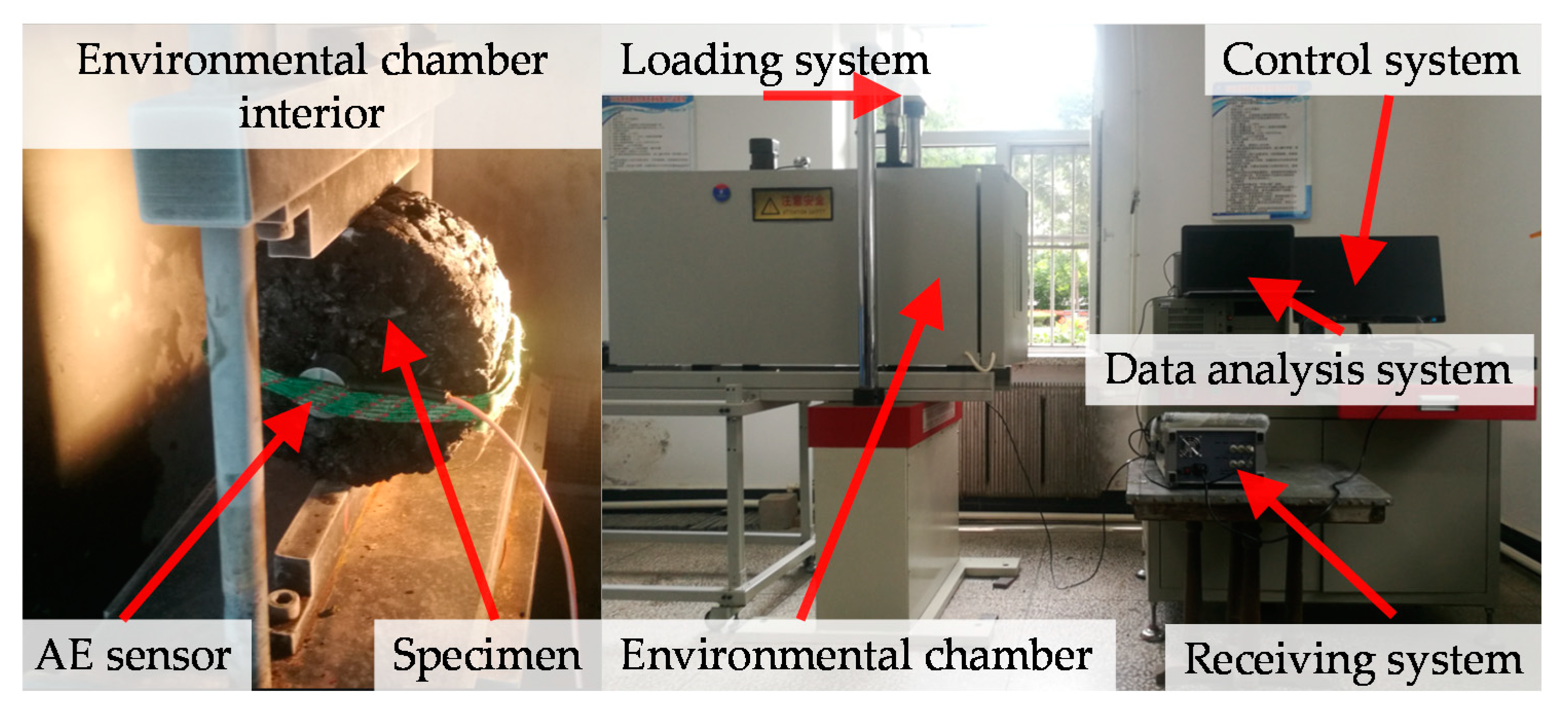
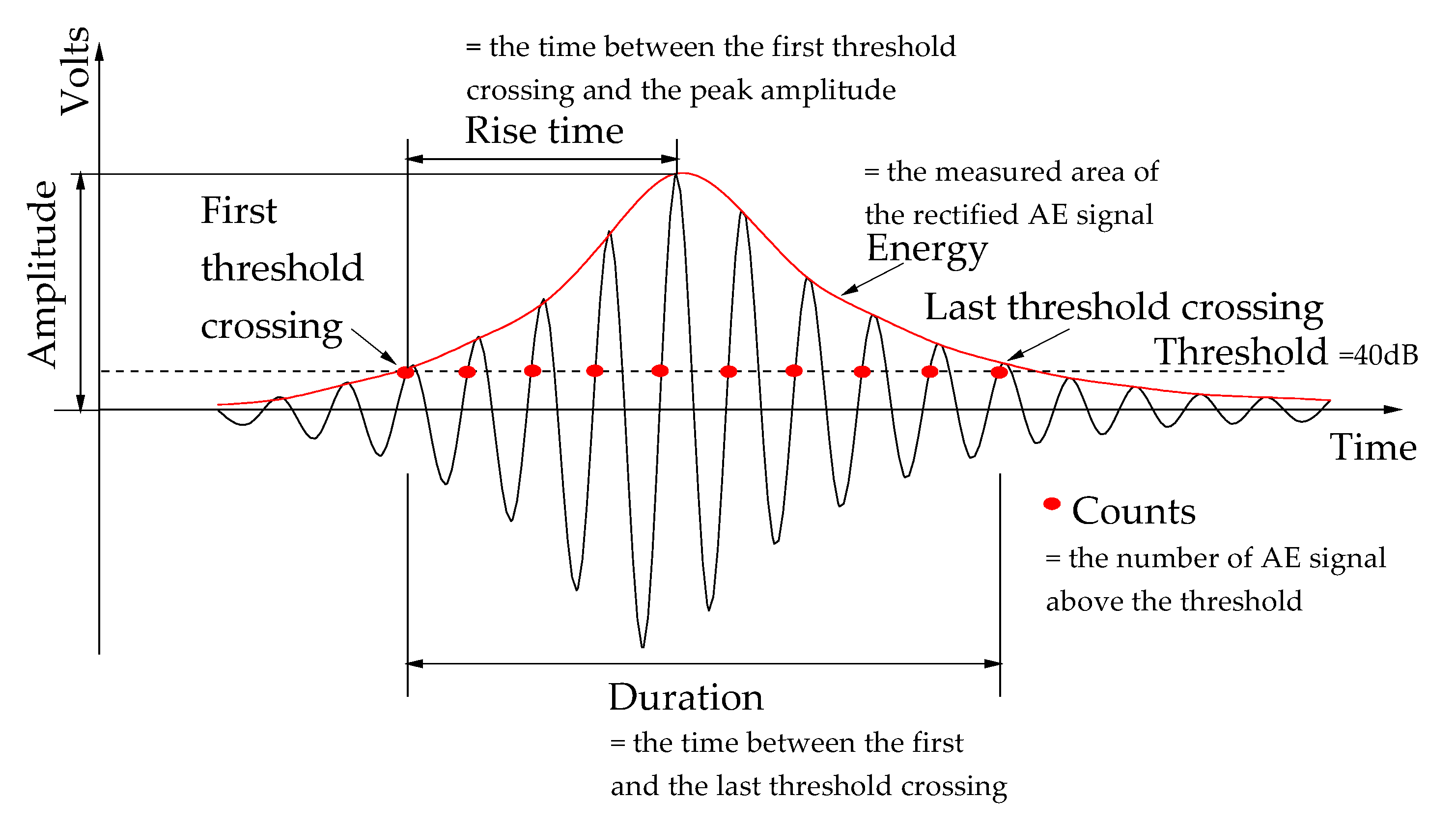

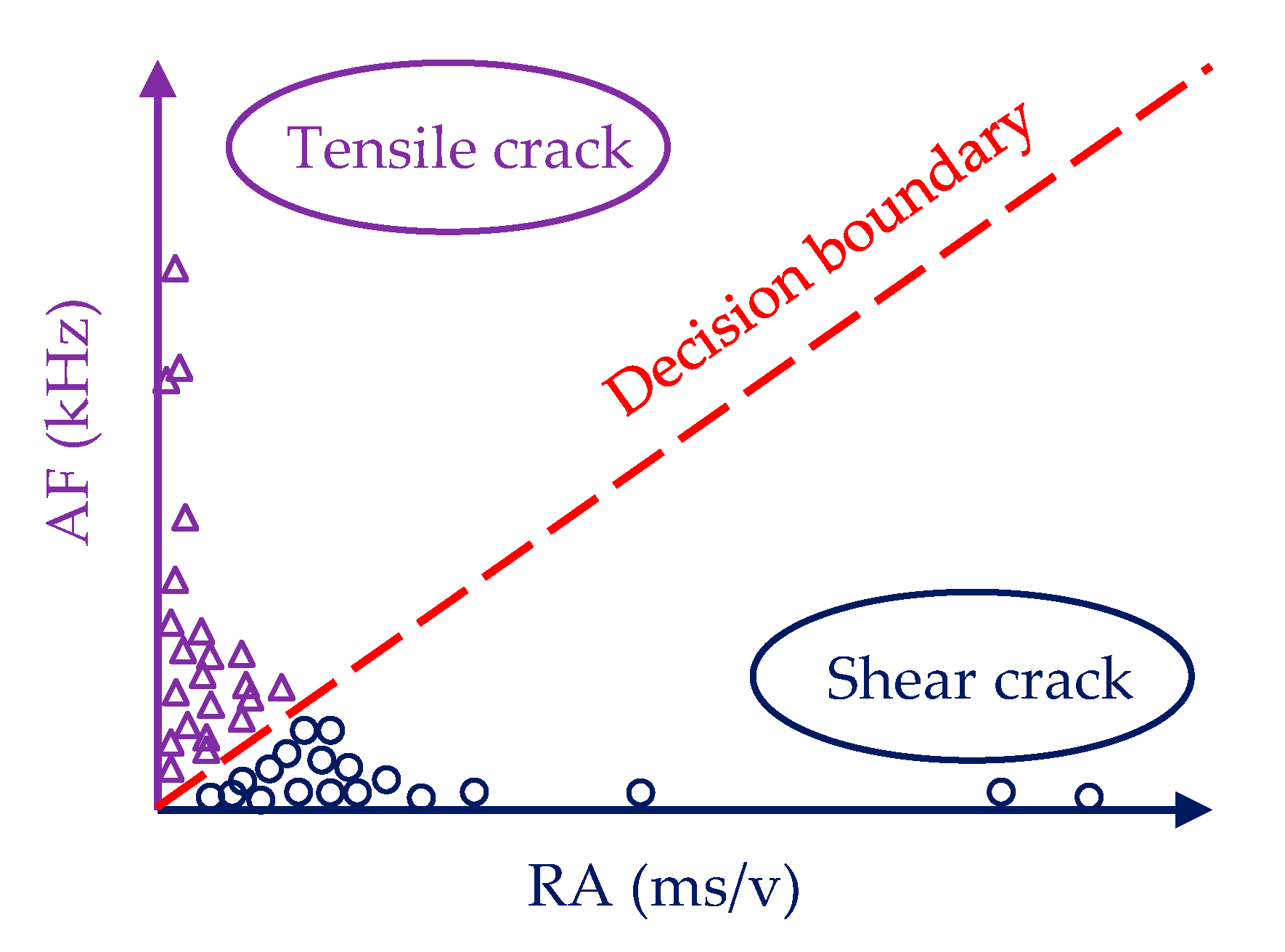
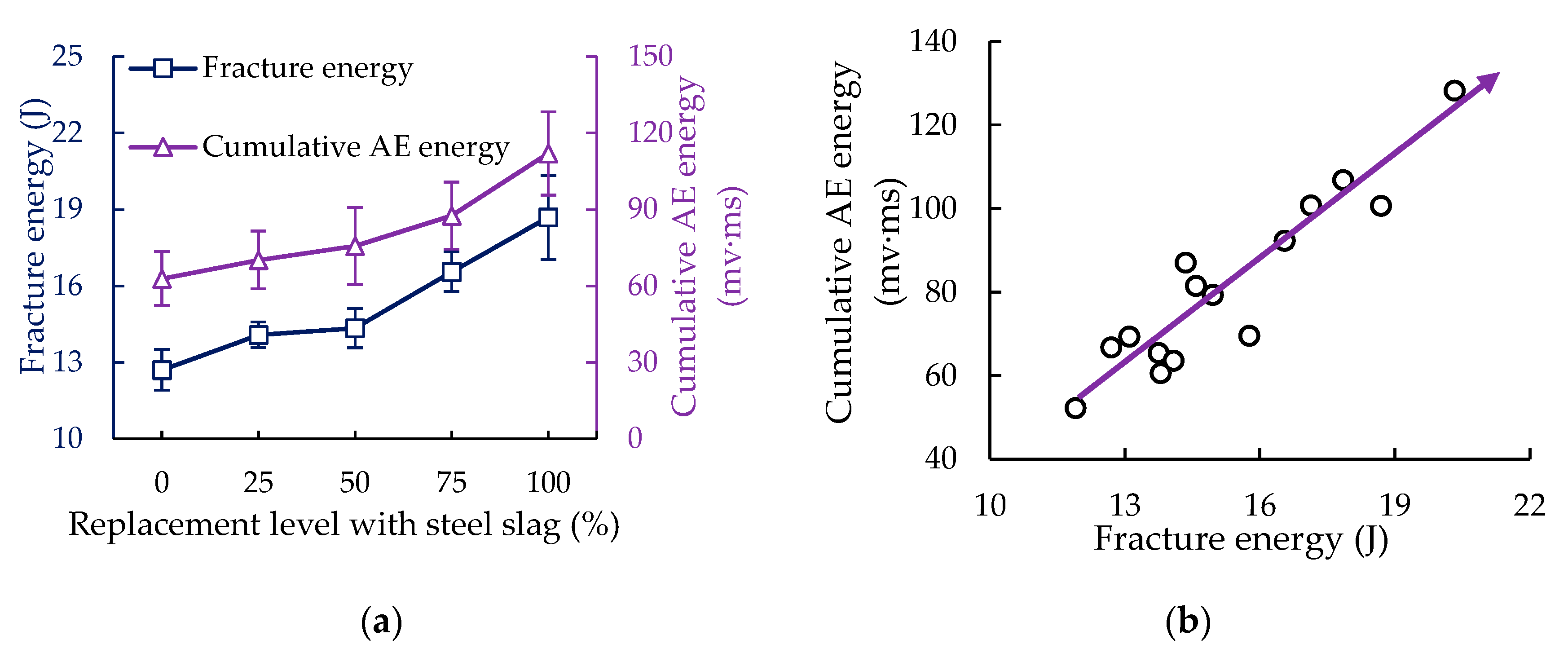

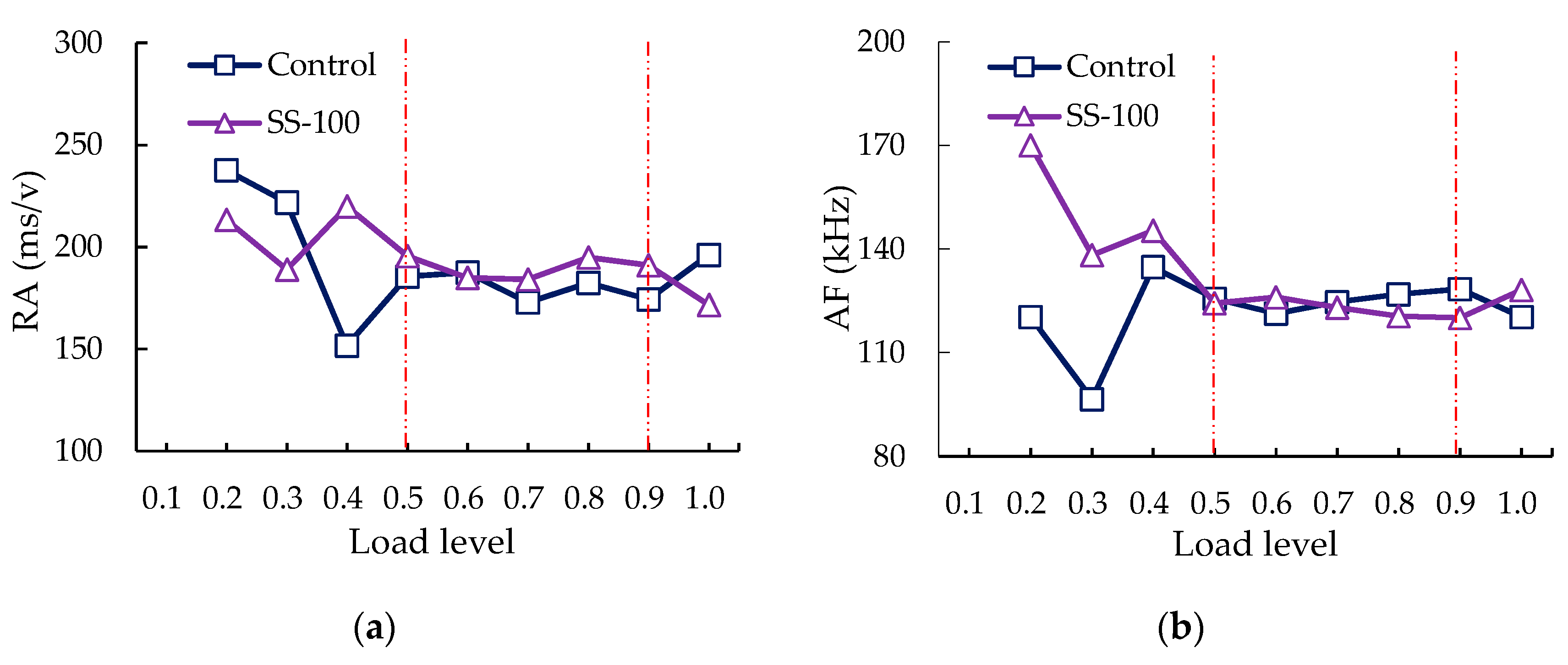
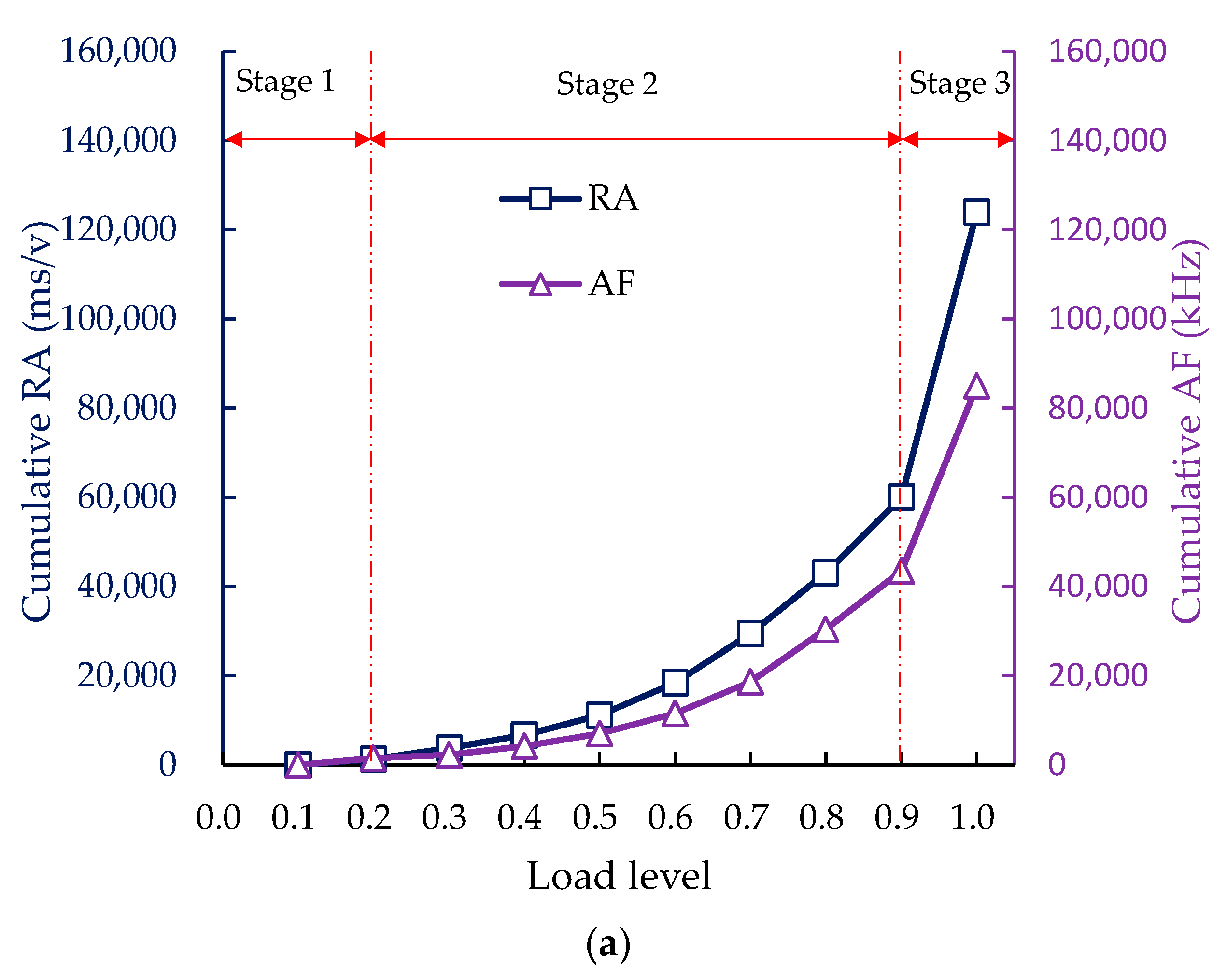
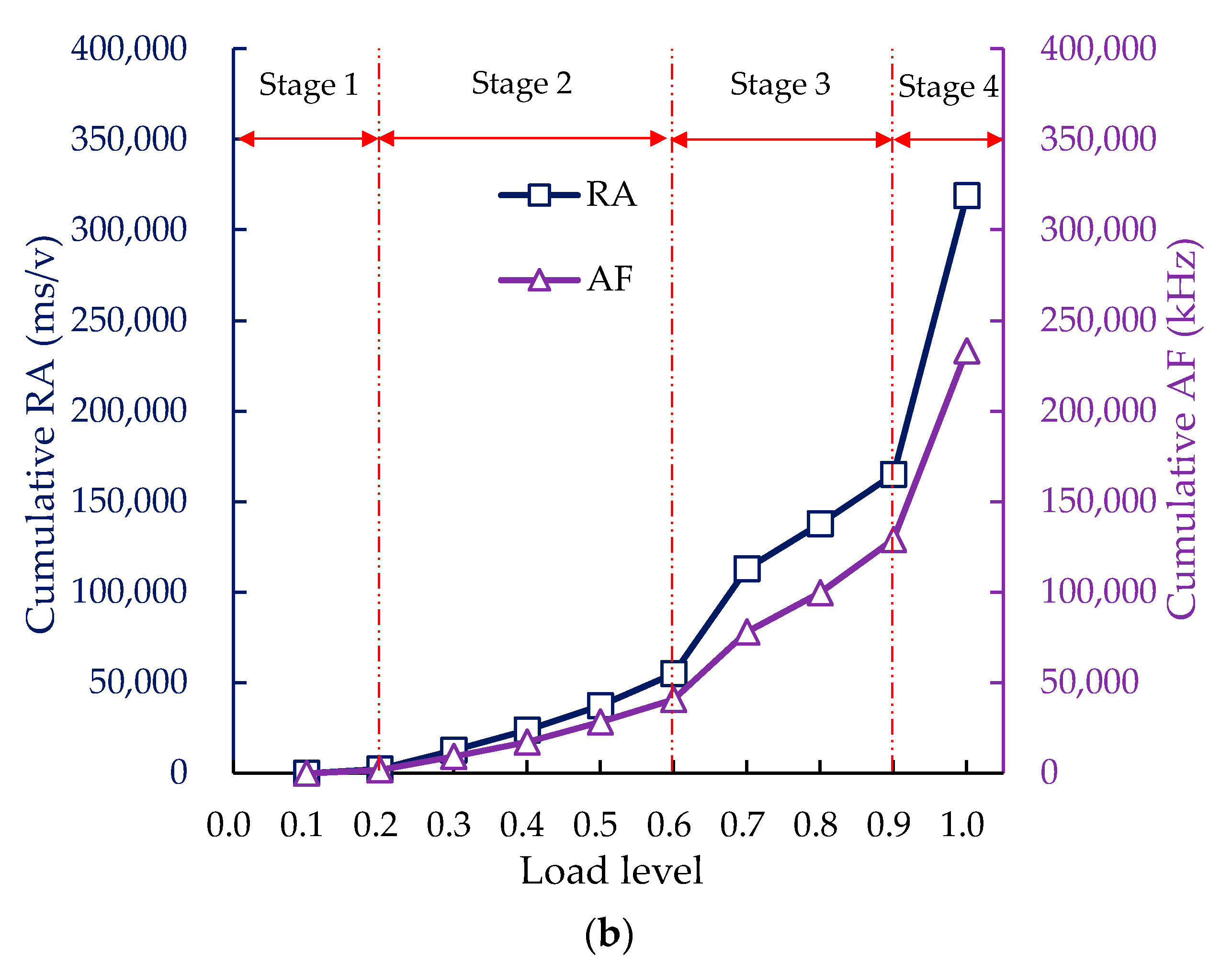


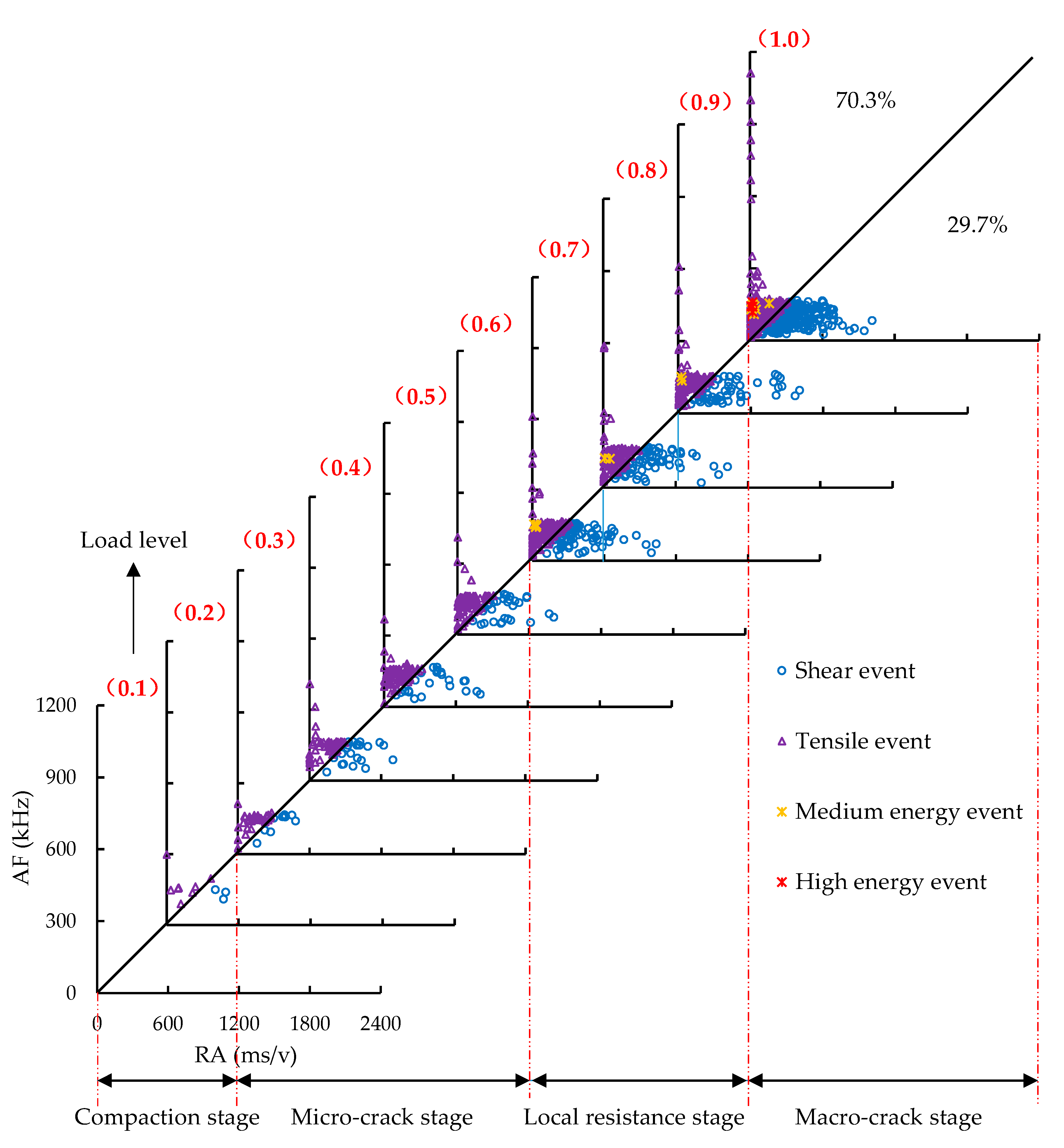
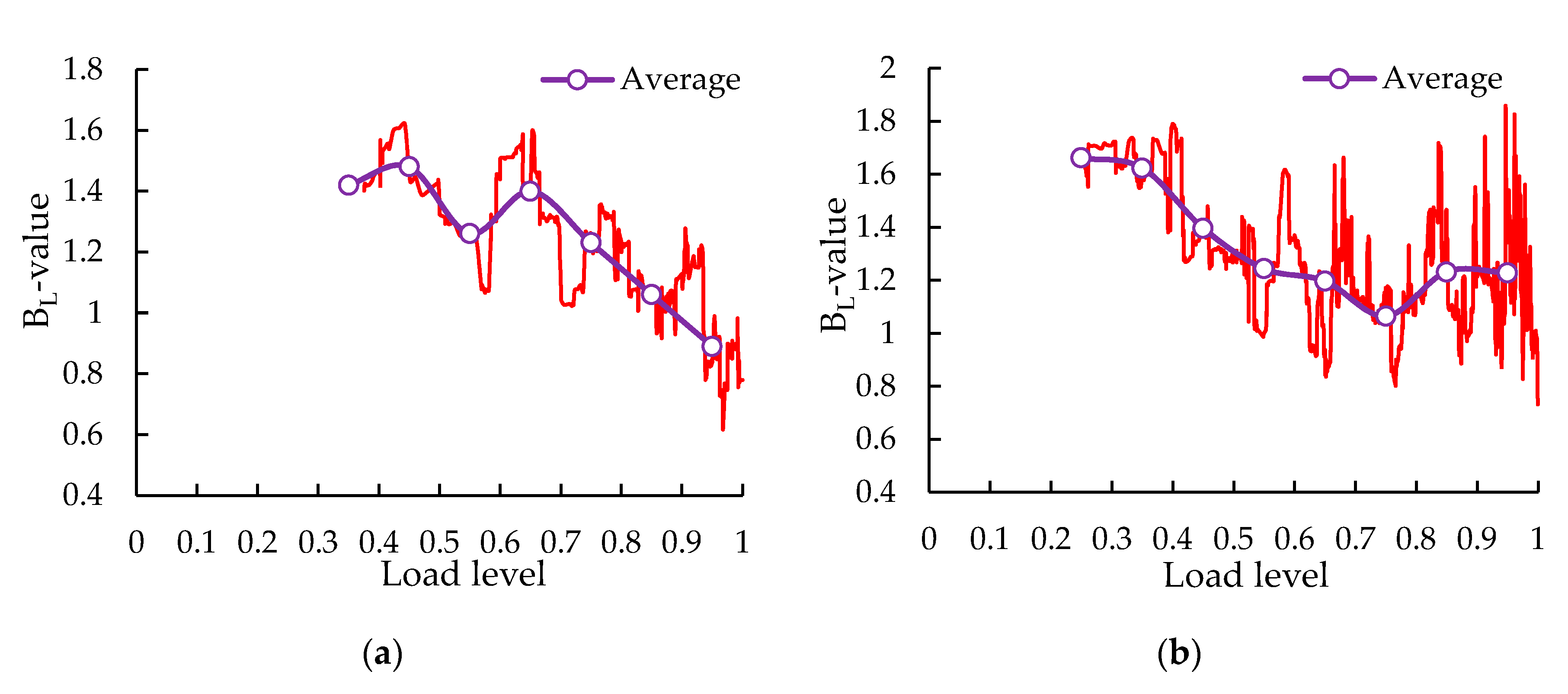

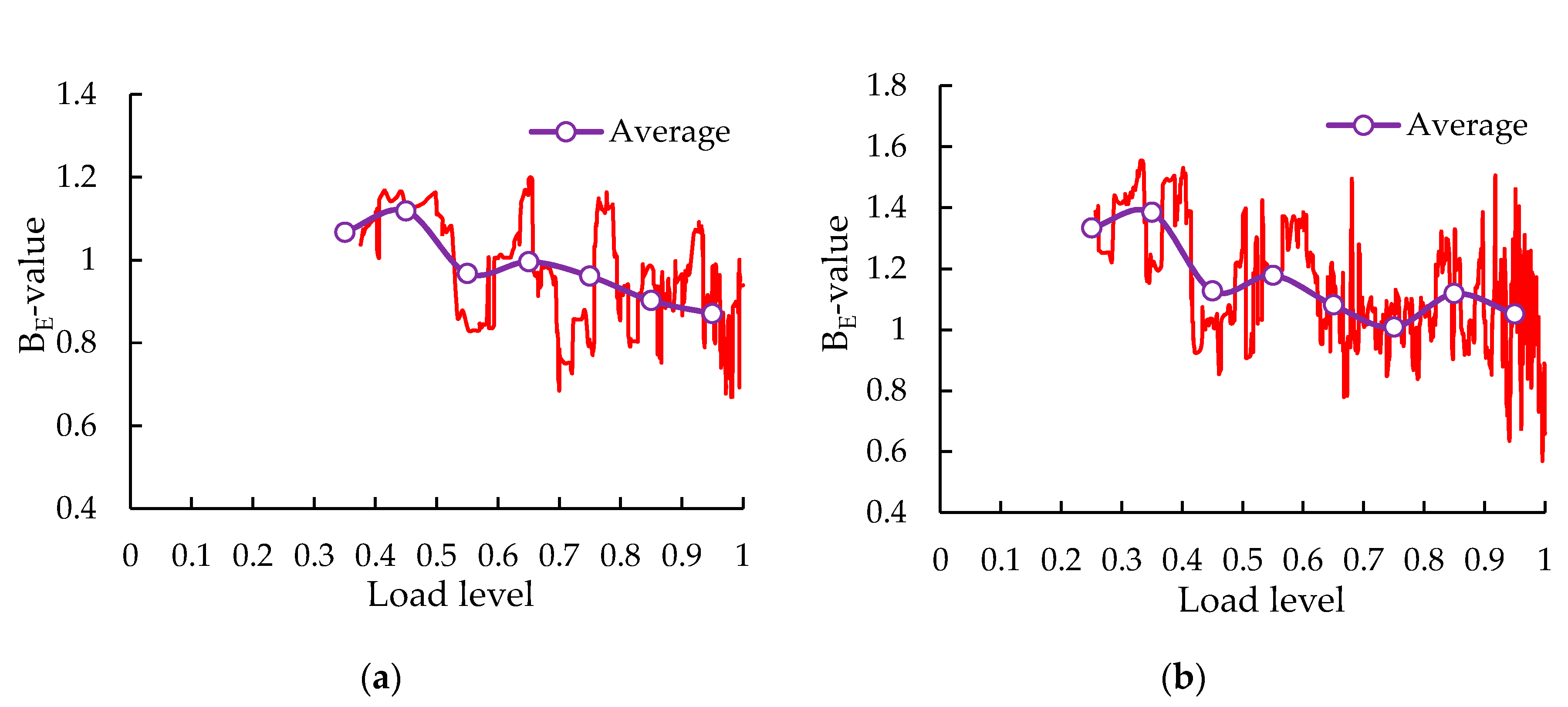
| Properties | Test Values | Specification |
|---|---|---|
| Penetration (25 °C, 0.1 mm) | 69.2 | 60–80 |
| Softening point (°C) | 63.5 | ≥55 |
| Ductility (5 °C, cm) | 42.7 | ≥30 |
| Flash point (°C) | 261 | ≥230 |
| Elastic recovery (25 °C, %) | 91.6 | ≥65 |
| After TFOT | ||
| Mass loss (%) | 0.24 | ≤±1.0 |
| Penetration ratio (25 °C, %) | 67 | ≥60 |
| Ductility (5 °C, cm) | 31 | ≥20 |
| Item | Basalt | Steel Slag | Specification |
|---|---|---|---|
| Los Angeles abrasion (%) | 17.9 | 12.7 | ≤28 |
| Flakiness content (%) | 4.8 | 4.53 | ≤10 |
| Crushed value (%) | 16.8 | 13.9 | ≤26 |
| Expansion (%) | 0.12 | 0.44 | ≤2.0 |
| Item | Test Values | Specification |
|---|---|---|
| Apparent density (g/cm3) | 2.64 | ≥2.5 |
| Water absorption (%) | 1.13 | — |
| Angularity (s) | 39.5 | ≥30 |
| Sand equivalent (%) | 71.4 | ≥60 |
| Sieve Size (mm) | Control | SS-25 | SS-50 | SS-75 | SS-100 |
|---|---|---|---|---|---|
| 0.075 | 5.0 | 4.8 | 4.6 | 4.4 | 4.3 |
| 0.15 | 6.8 | 6.5 | 6.3 | 6.0 | 5.8 |
| 0.3 | 7.9 | 7.6 | 7.3 | 7.0 | 6.8 |
| 0.6 | 10.5 | 10.1 | 9.7 | 9.3 | 9.0 |
| 1.18 | 12.9 | 12.4 | 11.9 | 11.5 | 11.1 |
| 2.36 | 16.7 | 16.0 | 15.4 | 14.8 | 14.3 |
| 4.75 | 23.4 | 23.0 | 22.6 | 22.2 | 21.8 |
| 9.5 | 66.4 | 66.2 | 66.0 | 65.8 | 65.7 |
| 13.2 | 94.7 | 94.7 | 94.7 | 94.7 | 94.7 |
| 16 | 100.0 | 100.0 | 100.0 | 100.0 | 100.0 |
| Items | Control | SS-25 | SS-50 | SS-75 | SS-100 | Specification |
|---|---|---|---|---|---|---|
| VV 1 (%) | 19.89 | 20.78 | 21.6 | 21.8 | 21.81 | 18–25 |
| VMA 2 (%) | 26.49 | 27.11 | 27.70 | 27.93 | 27.81 | — |
| VFA 3 (%) | 24.90 | 23.35 | 22.01 | 21.96 | 21.56 | — |
| Permeability (mm/s) | 2.85 | 2.97 | 3.12 | 3.23 | 3.25 | ≥2.80 |
| Cantabro abrasion loss (%) | 12.8 | 11.2 | 10.6 | 9.5 | 8.7 | ≤15 |
| Draindown (%) | 0.28 | 0.27 | 0.25 | 0.24 | 0.21 | ≤0.3 |
| MS 4 (kN) | 6.75 | 7.59 | 7.64 | 8.21 | 8.51 | ≥5.0 |
| FL 5 (0.1mm) | 31.5 | 32.2 | 32.6 | 32.5 | 31.8 | 20–40 |
| ITS 6 (MPa) | 0.633 | 0.635 | 0.659 | 0.706 | 0.749 | — |
| TSR 7 (%) | 85.63 | 89.34 | 89.37 | 90.65 | 90.85 | ≥85% |
| Items | Control | SS-25 | SS-50 | SS-75 | SS-100 |
|---|---|---|---|---|---|
| LITS 1 (MPa) | 2.977 | 2.972 | 2.940 | 2.766 | 2.727 |
| Failure strain (10−6) | 2307 | 2544 | 2626 | 3204 | 3946 |
| Deformation energy (J) | 12.70 | 14.08 | 14.35 | 16.55 | 18.69 |
| Items | Control | SS-25 | SS-50 | SS-75 | SS-100 |
|---|---|---|---|---|---|
| VV (%) | 0.33 | 0.36 | 0.35 | 0.37 | 0.39 |
| VMA (%) | 0.16 | 0.16 | 0.18 | 0.19 | 0.19 |
| VFA (%) | 0.19 | 0.25 | 0.20 | 0.26 | 0.33 |
| Permeability (mm/s) | 0.04 | 0.06 | 0.05 | 0.05 | 0.06 |
| Cantabro abrasion loss (%) | 0.20 | 0.21 | 0.20 | 0.23 | 0.22 |
| Draindown (%) | 0.01 | 0.01 | 0.01 | 0.01 | 0.02 |
| MS (kN) | 0.28 | 0.30 | 0.30 | 0.33 | 0.34 |
| FL (0.1 mm) | 0.16 | 0.21 | 0.20 | 0.24 | 0.21 |
| ITS (MPa) | 0.02 | 0.01 | 0.01 | 0.01 | 0.02 |
| TSR (%) | 0.41 | 0.45 | 0.51 | 0.48 | 0.51 |
| LITS (MPa) | 0.02 | 0.02 | 0.03 | 0.02 | 0.03 |
| Failure strain (10−6) | 146.21 | 131.62 | 184.25 | 251.84 | 205.22 |
| Deformation energy (J) | 0.61 | 0.33 | 0.42 | 0.58 | 0.63 |
© 2020 by the authors. Licensee MDPI, Basel, Switzerland. This article is an open access article distributed under the terms and conditions of the Creative Commons Attribution (CC BY) license (http://creativecommons.org/licenses/by/4.0/).
Share and Cite
Zhu, B.; Liu, H.; Li, W.; Wu, C.; Chai, C. Fracture Behavior of Permeable Asphalt Mixtures with Steel Slag under Low Temperature Based on Acoustic Emission Technique. Sensors 2020, 20, 5090. https://doi.org/10.3390/s20185090
Zhu B, Liu H, Li W, Wu C, Chai C. Fracture Behavior of Permeable Asphalt Mixtures with Steel Slag under Low Temperature Based on Acoustic Emission Technique. Sensors. 2020; 20(18):5090. https://doi.org/10.3390/s20185090
Chicago/Turabian StyleZhu, Bing, Hanbing Liu, Wenjun Li, Chunli Wu, and Chao Chai. 2020. "Fracture Behavior of Permeable Asphalt Mixtures with Steel Slag under Low Temperature Based on Acoustic Emission Technique" Sensors 20, no. 18: 5090. https://doi.org/10.3390/s20185090




